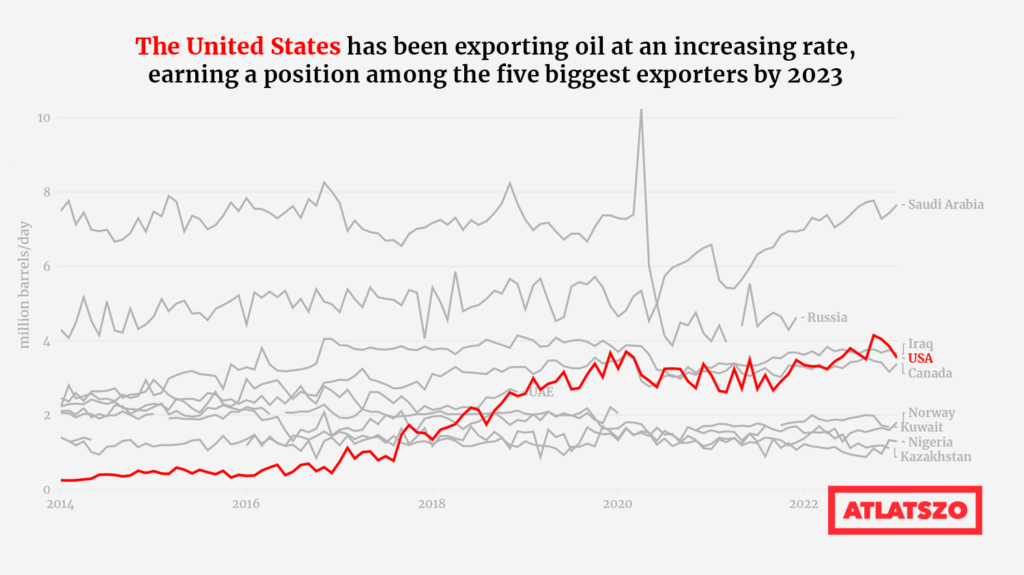The https://english.atlatszo.hu use cookies to track and profile customers such as action tags and pixel tracking on our website to assist our marketing. On our website we use technical, analytical, marketing and preference cookies. These are necessary for our site to work properly and to give us inforamation about how our site is used. See Cookies Policy
US oil dumping threatens Russian economy – history repeating itself?
By March, international oil prices had fallen well below pre-war levels, while the United States had become Europe’s largest oil supplier and one of the world’s biggest oil exporters. Eight years ago, similar movements in the oil markets caused the collapse of the Russian Rouble. Today, Russian oil industry is still profitable, but Moscow has reasons to be worried about prices.
On 14 March, US President Joe Biden’s cabinet approved the long-delayed Willow project to extract Arctic oil from Alaska. The decision came as a shock to many, as Biden had promised in his 2020 campaign that he would not approve new oil projects on federal lands.

The ConocoPhillips company will start work on 93 million hectares of oilfields, estimated to contain 600 million barrels of oil. Although the project had already been approved by former President Donald Trump, it was overturned by an Alaskan court due to environmental concerns. The project will likely cause serious damage to the pristine natural environment of Alaska. The carbon footprint of 600 billion barrels of oil (assuming it is all burnt as petrol) is the equivalent to the emissions of 2 million new cars.
A few weeks after the controversial Alaskan oil drilling project was approved, the Biden administration also started auctioning off more than 73 million hectares in the Gulf of Mexico for offshore oil and gas drilling.
Despite the Democratic party’s green reputation, in recent years there has been little difference between the parties in their approach to the domestic oil industry.
Biden’s policies mirror those of his Democratic predecessor, Barack Obama, who also used US oil exports as a weapon in a geopolitical conflict, one very similar to the one we are now in.
In 2014, when Russia launched its first attack on Ukraine, the United States sold oil from its Strategic Petroleum Reserve (SPR) for the first time since 1990. The release of 5 million tonnes of oil heralded what was to come in the years to come: the United States joined the club of the world’s largest oil exporters, while world oil prices began to fall at an unprecedented rate.
Thanks to the shale oil revolution and the introduction of fracking, US oil production overtook that of Russia and Saudi Arabia. Fracking is also a controversial technology. Many green politicians and activists argued for banning it because of its environmental risks, but the Obama administration has (at least initially) relaxed regulations on oil production.
The following year, the US government lifted the ban on oil exports that had been in place since the 1970s and entered the world market. Within a few years, the US had become one of the world’s largest oil exporters.
The big loser in the process was Russia – so much so that it is hard not to see Obama’s oil policy as a strategy in a geopolitical battle, following Russia’s 2014 aggression. The oil price crash dealt a severe blow to the Russian economy: in one year, the ruble fell by half to a third against major currencies, the RTS stock market index plummeted by 30 percentage points and the Russian economy went into recession for the next two years.
Eight years later, Western countries are also using oil to punish Moscow fo their repeated aggression in Ukraine.
The European Union and the US have halted offshore imports of Russian oil and gas, and a price cap has been imposed on hydrocarbons coming through the pipeline. Most EU countries have sought to reduce imports of Russian oil and replace it from new sources. By December 2022, the United States, not Russia, was the EU’s largest oil supplier.
The Kremlin claimed that such sanctions will not harm the Russian economy, as Russia would just find new buyers for oil and gas. They were partially correct: as the Russia Fossil Tracker shows, the volume of Russia’s oil exports remains stable since the war, largely due to increased trade with China. However, Russia’s revenue from selling the same amount of oil is decreasing due to the drop of oil prices, which fell at a rate approaching the 2014 oil crash.
What is behind the new price crash? Partly it is the effect of the European Union’s price cap, which forces Russia to sell fuel to many of its partners below market value. It is also however the result of increasing US oil exports: in March 2022, Washington touched the strategic oil reserve again, releasing 30 million barrels of crude oil. On a year-to-year basis, US oil exports rose by 22% (3.6 million barrels per day). This is only partially due to Washington tapping into the strategic reserve, as raw production also increased by 5.6 percent year-on-year (629 thousand barrels/day).
Cheap oil is a grave threat to Russia, not only because its economy is highly dependent on oil exports, but also because the costs of extracting oil in Russia are very high.
According to a 2019 study, extracting a barrel of Russian oil costs on average around $42 to extract, more than double the cost of extracting a barrel of Saudi Arabian oil. This means that if the price of oil falls, the point could come sooner when a significant proportion of Russian oil producers could only produce at a net loss. Of course, the extraction of US shale oil is not cheap either, although the cost depends largely on the location of the deposit. In 2020, extraction costs for US shale oil producers ranged between $27 and $40.
In March this year, the world price of Russian crude oil fell below $50 based on the Urals benchmark. This is still well above the January 2016 low, but just over half of pre-war levels. In January the Urals dipped below $40, although this did not prove to be sustainable.
In March 2023, the market price of Russian crude oil (based on the Urals benchmark) fell below $50. This is still well above the January 2016 low, but just over half of pre-war levels. The question is whether the oil price can reach the below-$40 level, which would be disastrous for Moscow. Russia may be reassured by the fact that the shale oil revolution was a one-off phenomenon, and the fact that the new US oil projects will not start producing oil for years.
However, Washington still has ways to boost oil production or exports, including economic incentives and oil companies and further tapping into the strategic reserves – in any case, the taboo has already been broken, with the Biden cabinet abandoning its green image.
In addition, an escalating banking crisis could push oil prices lower. Although the war has essentially forced Russia out of the international banking system, the Russian economy would also suffer if more large banks collapse. Investors selling their assets 40 in the event of a worsening financial crisis could hit oil prices. Some analysts predict WTI to go as low as $40 – as Russian Urals is typically priced below WTI, this would lead to a severe crisis of the Russian oil industry.
Written by Krisztián Szabó and Zalán Zubor. Translated by Zalán Zubor. The original Hungarian version of this story can be found here.



